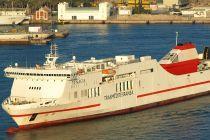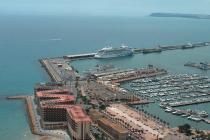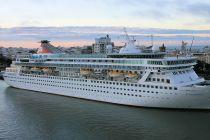Valencia (Spain)
Cruise Port schedule, live map, terminals, news
Region
Mediterranean - Black Sea
Local Time
2025-03-28 17:04
 62°F
62°F 16.4°C

 Gentle breeze
Gentle breeze4.5 m/s
 69 °F / 21 °C
69 °F / 21 °C 49 °F / 10 °C
Port Valencia cruise ship schedule shows timetable calendars of all arrival and departure dates by month. The port's schedule lists all ships (in links) with cruises going to or leaving from Valencia, Spain. To see the full itineraries (ports of call dates and arrival / departure times) and their lowest rates – just follow the corresponding ship-link.
| Day | Ship | Arrival | Departure |
|---|---|---|---|
| 8 March, 2027 Monday | |||
| 18 March, 2027 Thursday | |||
| 22 March, 2027 Monday |
Valencia is a major Mediterranean port city in eastern Spain, located close to the mouth of Tura River. The city is the capital of the autonomous Valencian Community (Spain's 4th most populous autonomous - after Andalusia, Catalonia and Madrid) and Spain's 3rd-largest city by population (around 1,6 million, metro around 2,5 million) - following Madrid and Barcelona.
Port Valencia (locode ESVLC) is currently ranked Europe's 5th-largest and Mediterranean's busiest containership port.
The city's best-known tourist attractions include two gates (from the 14th-century city walls), a Gothic cathedral (13th-15th centuries), Lonja de la Seda (14th-century silk exchange building), Castillo de Peniscola (14th-century castle), fine arts museum. The settlement was founded by the Greeks and later occupied by Carthaginians, Romans, Visigoths, Arabs.
Valencia is best-known for its involvement in every Spanish war during the 19th-20th centuries. During the Spanish Civil War (1938-39), the Republican forces fled to Valencia after Catalonia's fall.
Port Valencia
The seaport is Europe's 5th and Mediterranean's largest. The amount on annually handled cargo shipping volumes is around 55 million tons (cargoes) and over 4,2 million (TEU-containers). It annually handles 7500+ vessels. The annual number of handled passengers (ferry and cruise) is around 0,5 million. The port is also a major employer (with over 15,000 employees) and generates over half of the country's GDP.
Port's history dates back from 1483 AD, when King Ferdinand II of Aragon (1452-1516) granted permission for building a wooden bridge (named Pont de Fusta). Followed numerous construction projects, but mainly due to Turia River floodings the port remained unsuccessful. With the increase in shipping traffic over the years, in 1679 King Charles II of Spain (1661-1700) granted the port trading privileges with other kingdoms and states. In 1791, King Joseph I (1768-1844, brother of Napoleon Bonaparte) granted the port trading privileges with the Americas. Then Valencia became Spain's 6th maritime province.
In 2017, the port was visited by Silk Road International (SICO), one of China's most important non-governmental organizations promoting commercial, economic and cultural relations with other countries. SICO studied the possibility of opening its Mediterranean headquarters in the city.
Until November 2017, the port's total (direct) cargo shipping volume with China was 6,48 million tons (3,18% increase over 2016). The container ship cargo volume with China was 532,000 TEUs / containers (4,87% increase).
As of 2018, the seaport's traffic with China is 48%, making the country its main commercial partner. Port Valencian currently is linked with 80 Asian ports, the largest of which are Shanghai, Ningbo, Yantian, Qingdao, Xiamen, Tianjin, Hong Kong, Shekou-Shenzhen, Chiwan, Nansha-Guangzhou.
Valencia Port Authority (APV) manages a total of 3 seaports: Valencia, plus two satellite ports - Sagunto and Gandia. All are on the Mediterranean Sea (Spain's eastern coastline), along an 80 km / 50 mi stretch of the coast. The port has a total quay length 12 km ( 7,5 mi) and total storage area 1,2 km2 (0,5 mi2).
Port Sagunto has around 10% of valencia's total annual cargo shipping traffic capacity and specializes in LNG (liquefied natural gas), as well as iron and steel products. Over 3 million tons of LNG are shipped annually to supply the nearby regasification plant. Around 2/3 of the port's traffic is iron and steel products. The other 1/3 are fertilizers, construction materials, timber.
Port Gandia has around 1,5% of Valencia's total annual cargo shipping traffic and specializes in forestry products export and import (timber, reels, pulp and paper, furniture).
In 2018, Port Valencia surpassed Port Barcelona in terms of total handled vehicle units. Port's all car terminals (including those at Sagunto and Gandia) handled 818,225 vehicles (3,17% increase over 2017). Barcelona's volume was 809,158 (3,26% decrease). Spain's total vehicle shipping traffic was 3,395338 million units (-2,55% over 2017's 3,484212 units). Spain's other major vehicle ports (handled units in 2018) are Santander (488,144), Vigo (451,111), Pasajes (254,673) and Tarragona (194,958).
In 2020, the Spanish passenger shipping company BALEARIA launched an LNG-bunkering facility (liquefied natural gas) at Port Valencia. The new facility uses MTTS (Multi Truck to Ship) bunkering system that enables several gas trucks to simultaneously bunker (refuel) the berthed ferries. The equipment was manufactured by Kosan Crisplant (Denmark). The bunkering speed ranges between 80-120 m3 LNG per hour. The first LNG-fueled ship here was Hypatia de Alejandria with crossings between Valencia-Ibiza-Palma de Mallorca.
On July 2, 2020, BALEARIA submitted a tender bid (the only one) for a new passenger terminal construction and operation under concession. The new terminal is located at Muelle Perfecto Palacio de la Fuente Dock (fka Muelle Espigon Turia Norte Dock), in the area of a former shipyard (Union Naval de Valencia) sized ~100,000 m2 (~0,04 mi2). The concession rights for the new facility are for 35 years, extendable to max 50 years.
Muelle de Poniente and the Muelle Perfecto Palacio
- The new facility (Valencia Terminal Europa) will serve cruise ships, regularly scheduled ferries (linking daily to the Balearic Islands and Algeria) and RoRo ships (wheeled cargo and car carriers). The terminal will have 4 berths (minimum), at least one of which will have capacity to serve world's largest cruise liners (max LOA length 360 m / 1181 ft) and one berth for ships with max LOA length 250 m (820 ft).
- All berths will have shorepower supply capabilities. The cruise terminal will have capacity to handle two ships simultaneously (1x homeported, 1x transitting) and two cruiseferries (RoPax ships).
- All the electrical energy used at the new facility will be produced at the terminal and of renewable origin (photovoltaic, wind, hydrogen, biofuel).
The new BALEARIA Terminal has estimated annual capacity ~370,000 passengers (the first 5 years / 2023-2028) and ~1 million passengers in the following years (projected annual growth ~2%). BALEARIA estimated that during the terminal's concession, the Port Authority will collect ~EUR 70 million (~USD 83M) from port taxes, tourists and goods.
In mid-November 2020, GPH-Global Ports Holding (via its partnership with Balearia Group) won a 35-year concession (2021 through 2056, plus an optional 15-year extension) for Valencia Cruise Port. By the contract, GPH operates and manages the port's cruise and ferry operations while BALEARIA will build two new passenger terminals as part of a EUR 31 million (~USD 37M) port infrastructure investments, including both terminals, ferry piers, outdoor car parking, retail shops, food-beverage facilities. BALEARIA's projects in Port Valencia are planned for completion in 2023-Q1. In 2019, the cruise port handled 203 ship calls and ~435,000 tourists.
Due to the COVID crisis, for FY2020 Port Valencia reported ~EUR 56 million (~USD 67M) in lost revenues estimated by not-handled passengers (EUR 145,5 pp). According to the report, the port's cruise business supports 637 local jobs. In FY2017 were handled 383,000 cruise ship tourists.
In the period 2008-2019, the port's business grew by 42% (from 52 million to 74M tonnes), CO2 emissions (per tonne managed) dropped by 30% (from 3,19 to 2,23 kg), with planned zero emissions in port by 2030.
In early-December 2021, were announced plans for Valenciaport to become Europe's first seaport using hydrogen technologies for reducing greenhouse gases/CO2 emissions.
- The H2PORTS project (budgeted EUR 4+ million / ~USD 4,5M) is a partnership between Valencia Port Authority and Fundacion Valenciaport. The project is funded by the FCH-JU program (Fuel Cell and Hydrogen Joint Undertaking) which finances R&D (research and development) and Demonstration projects on this environment-friendly (decarburization) technology. By the project will be prepared prototypes to be used for testing the new fuel-cell technology.
- The H2PORTS initiative also involves Centro Nacional del Hidrogeno (research institute in Ciudad Real), as well as the companies MSC Terminal Valencia (port operator), Grupo Grimaldi (ferries), Hyster-Yale Group (lift trucks manufacturer), Distretto Atena Future Technology (Distretto Alta Tecnologia Energia Ambiente/Naples Italy), Ballard Power Systems Europe (Hobro Denmark-based hydrogen fuel cells producer), Enagas (Madrid Spain-based energy company).
- By the H2PORTS project, in 2022 Valenciaport installed a mobile station (for hydrogen supply) served by a Reach Stacker (energy-powered vehicle) and a 4x4 tractor (fitted with a fuel cell system).
In early-January 2022, the Port Authority announced a EUR 1,98 billion (~USD 2,25B) investment plan through 2025. The plan includes EUR 27,4M (~USD 31,1M) for a new passenger terminal, EUR 60+M for alternative energy projects (electrical substation, PV solar cell panels, wind power), as well as infrastructure projects (railway access, port deepening/dredging, etc).
By the October 2022-approved EUR 17+ million project, the Port installed 10773 rooftop solar panels (on Grimaldi Terminal's roof/surface area 27,700 m2 / 298,160 ft2) with annual capacity ~8380 MWh (~11% of the Port's electrical power consumption).
On November 10, 2022, APV approved the award to BALEARIA for the construction/operation of the new passenger terminal. BALEARIA's investment exceeds EUR 37M, while APV's is EUR 61,8M (to total ~EUR 99 million). The refurbishment works on the existing docks (at the old shipyard) included the adaptation of all cargo berths (at Espigon del Turia/Muelle Perfecto Palacio, Muelle Grada Quay and Muelle Fondo Quay).
Valencia cruise terminal
On March 4, 2020, PAV (Port Authority of Valencia) put out to tender the new passenger terminal (construction and operation) concession. The new cruise and ferry passenger terminal covers land area approx 100,000 m2 (~0,04 mi2) and is located between Muelle de Poniente Pier and Muelle Perfecto Palacio de la Fuente/fka Espigon del Turia North Pier. The area was previously occupied by a container terminal operated by Union Naval Valencia SA since the 1970s. The 35-year concession is extendable for max 50 years. The deadline for submitting the tender offers was April 17, 2020.
The new passenger terminal will serve cruise ships, regular passenger ferries (linking to the Balearic Islands and Algeria) and Ro-Ro vessels (transporting wheeled cargoes). The terminal is planned with at least 4 berths, including at least one with LOA length 360 m (1181 ft) and the shortest to be with min LOA length 250 m (820 ft). All berths will be fitted with shoreside power supply. The terminal must have capacity to handle (dock) simultaneously two cruise ships (one homeported, one transiting) plus two ferries.
As amenities, the new facility (Valencia Terminal Europa) will have entrance hall, waiting area, luggage storage, cruise ship check-in area, WiFI Internet, security control (X-ray and metal detection points, CCTV cameras), spaces for Customs clearance and police forces, public restrooms, boarding bridges, tourist office, crew lounge, PAV office, warehouses, VIP area, shopping area, vending machines, ATMs, car rental kiosks, prayer room, accessibility for passengers with reduced mobility, short-stay car parking (min 100 lots), bus parking (min 10 lots), taxi rank, kids playground, restaurant, rooftop solar powerplant (PV/photovoltaic system of electricity-generating panels).
- Cruise Industry

MSC Splendida's 2025-2026 Mediterranean & South American itineraries
MSC Splendida is set to maintain a prominent presence in the Mediterranean throughout 2025, offering a variety of itineraries that cater to diverse...
March 14, 2025 - Accidents

Flooding in Spain delays Royal Caribbean's ship Adventure OTS Transatlantic cruise by 2 days
Adventure of the Seas, currently undergoing scheduled maintenance in Cadiz (Spain) has faced delays due to the region's severe rain and flooding...
November 17, 2024 - Accidents

Refit delays force Marella UK to cancel Discovery 2 ship’s “Spanish Flavours” cruise
Marella Cruises announced the cancellation of a scheduled voyage of Marella Discovery 2 ship due to an extended drydocking at Navantia Shipyard in...
November 5, 2024 - Cruise Industry

MSC Cruises highlights Mediterranean's sunniest spots for winter getaways
MSC Cruises is offering guests the opportunity to extend their holiday season with a variety of Mediterranean sailings through October, November, and...
August 31, 2024 - Accidents

Engine room fire on GNV Tenacia ferry prompts evacuation of 350 passengers
Spanish rescue authorities are overseeing the evacuation of 350 passengers from the Italian ferry Tenacia after a fire in the engine room disabled...
July 9, 2024 - Cruise Industry

Costa Cruises introduces tailored family experiences across the Mediterranean
Costa Cruises introduces a new feature designed to make Mediterranean Sea voyages more memorable for families, offering unique experiences tailored...
June 29, 2024 - Cruise Industry

Alicante (Spain) embraces cruise tourism amid Valencia's tightened regulations
Alicante (Spain) has positioned itself as a welcoming destination for cruise ships and tourists, distinguishing itself from Valencia, which...
May 31, 2024 - Cruise Industry

MSC Cruises unveils summer 2026 Mediterranean itineraries
MSC Cruises caters to the ongoing allure of the Mediterranean by offering an extensive range of itineraries, allowing travelers to explore multiple...
May 24, 2024 - Cruise Industry

Windstar announces winter Mediterranean cruises for 2025-2026 season
The premium travel brand Windstar is set to offer an impressive array of winter Mediterranean voyages for the 2025-2026 season, showcasing a diverse...
May 23, 2024 - Cruise Industry

Fred Olsen announces Mediterranean fly-cruises for Balmoral ship in 2025
The UK-based Fred Olsen Cruise Lines has unveiled its Mediterranean fly-cruises aboard MS Balmoral ship for 2025. Passengers can embark on 7- to 12...
March 13, 2024 - show more news
